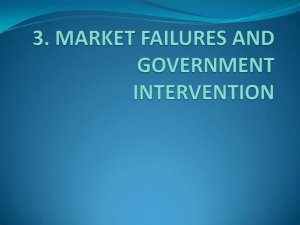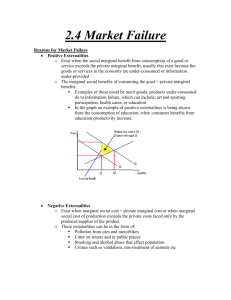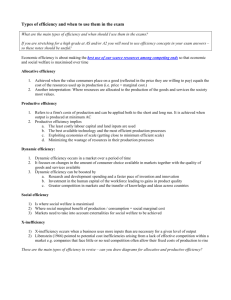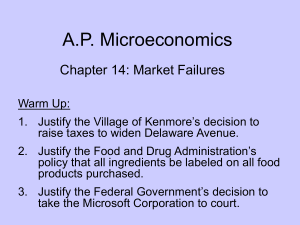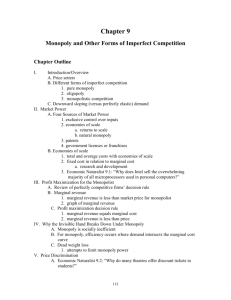Six Market Failures
advertisement
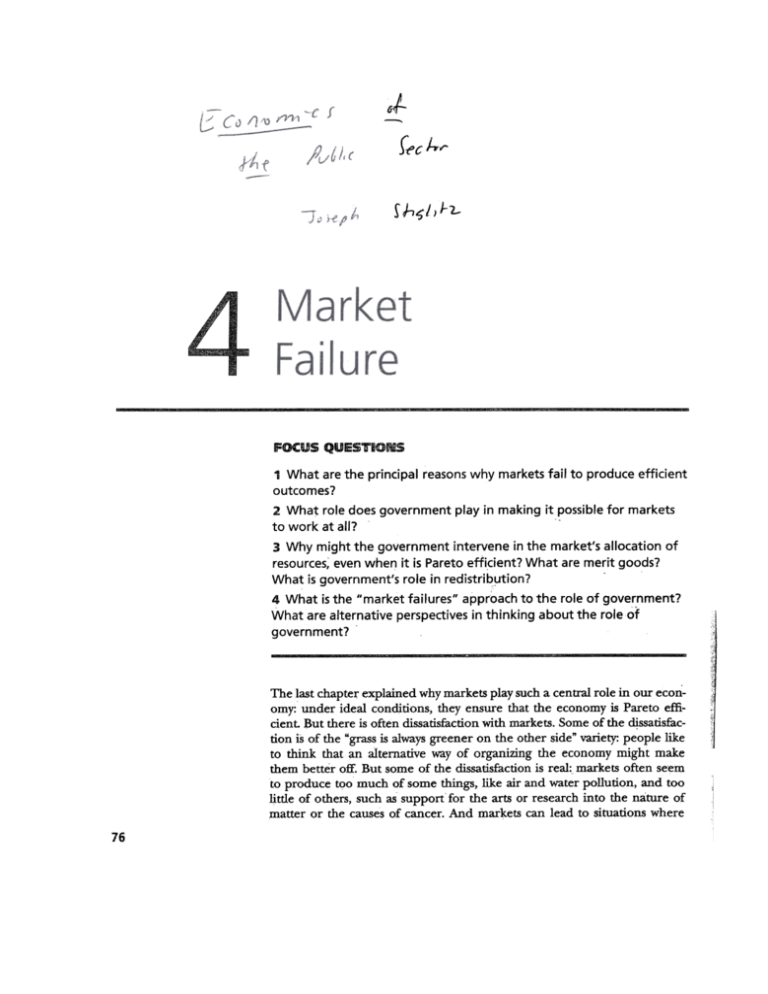
uJ- fec J..,..r fh'5'IIJ-"2- FOCUS QUESTIONS 1 What are the principal outcomes? reasons why markets fail to produce efficient 2 Wha~ role does government to work at all? play in making it possible for markets - 3 Why might the government intervene in the market's allocation of resources; even when it is Pareto efficient? What are merit goods? What is government's role in redistribution? . 4 What is the "market failures" appr-oach to the role of government? What are alternative perspectives in thinking about the role of government? The last chapter explained why markets play such a central role in our economy: under ideal conditions, they ensure that the economy is Pareto efficient. But there is often dissatisfactionwith markets. Some of the dissatisfaction is of the "grassis alwaysgreener on the other side" variety: people like to think that an a1temative way of organizing the economy might make them better off. But some of the dissatisfactionis real: markets often seem to produce too much of some things, like air and water pollution, and too little of others, such as support for the arts or research into the nature of matter or the causesof cancer. And markets can lead to situations where 76 some people have too little income to live on. Over the past fifty years,economists have devoted enormous efforts to understanding the circumstances under which markets yield efficient outcomes, and the circumstances in which they fail to do so. This chapter wi1llook both at these market failures and at the reasons why governments intervene in markets evenwhentheyareefficient. PROPERTY RIGHTS AND CONTRACT --Chapter 3 explained why markets result in Pareto efficient outcomes. But even for markets to work, there needs to be a government to define pro~ ertYrights and enforce contracts, In some societies,land is held in common; anyone can gr"ilZetheir cattle and sheep o~ it. Since no one has the property right to the land, no one has an incentive to ensure that there is not overgrazing. In the former communist countries, property rights were not well denned, so people had insufficient incentive to maintain or improve their apartments.'In market economies, the benefits of such improvements are reflected in the market price of the property. Similarly, if individuils are to engage ill transactionswith each other, the contracts they sign must be enforced. Consider a typical loaN, where one person borrows money from another, and signs a contract to repay it. Unless such contracts are enforced, no one would be willing to make a loan. At an even more primitive level, unless there is protection of private property, people will have insufficient incentive to save and invest, since their savingsmight be taken away. Government activities aimed at protecting citizensand property, enforcing contracts, and defining property rights can be thought of as providing the foundations on which all market economiesrest. MARKET FA.ULURES AND THE ROLE OF GOVERNMENT The first fundamental theorem of welfare economics assertsthat the economy is Pareto et'ficient only under certain circumstances or conditions. There are six important conditions under which markets are not Pareto efficient. These are referred to asmarket failures, and they provide a rationale for government activity. 1 FAiLURE COMPETIT9C1\1 CF For markets to result in Pareto efficiency, there must be perfect competition-that is, there must be a sufficiently large number of firms that each believesit has no effect on prices. But in some industries-supercomputers, aluminum, cigarettes,greeting cards-there are relatively few firms, or one or two firms have a large share of the market. When a single firm supplies the markt:t, economists refer to it as a monopoly; when a few firms supply the market, economists refer to them asan oligopoly. And even when there are many firms, each may produce a slightly different good and may thus 77 4 MARKET FAILURE perc~ive itself facing a downward-sloping demand curve. Economists refer to such situations as monopolistic competition. In all of these situations, competition deviatesfrom the ideal of perfect competition, where each firm is so small that it believesthere is nothing it can do to affect prices. It is important to recognize that under these circumstances,firms may still seem to be competing actively against each other, and that the market economy may seem to "work" in the sensethat goods are being produced which consumers seem to like. The first fundamental theorem of welfare economics-the result that market economies are Pareto efficient-requires more thanjust that there be somecompetition. As we sawin the last chapter, Pareto efficiency entails stringent conditions, like exchange, production, and product mi:1':efficiency,and these conditions typicallyare satis.,l fied only if each firm and household believesthat it has no effect on prices. There are a variety of r:easonswhy competition may be limited. When averagecostsof production decline as a firm produces more,1 a larger firm will have a competitive advantageover a smaller firm. There may even be a natural monopoly, a situation where it is cheaper for a single firm to produce the entire output than for eaCh9f severalfirms to produce part of it. Even when there is not a natural monopoly, it maybe efficient for there to be only a few firms operating. High transportation costs mean that goods sold by a firm at o~e location are not perfect substitutesfor goods sold at another location. Imperfect information may also mean that if a firm raises its price it will not lose all of its customers;it only facesa downward-sloping demand CUIVe. Firms may also engagein strategic behavior to discouragecompetition. They may threaten to cut prices if potential rivals enter, and such threats may both be credible and seIVeto discourage entry. Finally, some imperfections of competition arise out of government actions. Governmentsgrant patents-exclusive rights to an invention-to innovators. While patents are important in providing incentives to innovate, they make competition in the product market lessthan perfect. The market dominance of such firms as Xerox, Alcoa, Polaroid, and Kodak was based on patents. Of course, even without patents, the fact that an innovator has some information (knowledge) that is not freely available to others may enable it to establisha dominant market position. It is easy to see why imperfect Gompetition leads to economic inefficiency. We saw earlier that under competition, firms set output at the P~eto efficient level. They set price t:qual to the margin3l cost of production. Price can be thought of as measuring the marginal benefit of consuming an extra unit of the good. Thus, with~competition, marginal benefits equal marginal costs.Under imperfect co~petition, firms set the extra revenue they obtain from selling one UIiit more-the marginal revenue-equal to the marginal cost.With a downward-slopingdemand cuIVe, the marginal revenue has two cbmpon~nts.When a firm sells an extra unit, it receivesthe 1 Declining average costs couespond :han doubles output. 78 to increasing returns: doubling inputs more ~ MARKET FAILURES AND THE ROLE OF GOVERNMENT FHcaURIE 4.1 Monopoly Pricing Monopoly output is lower than competitJve output, the output at which profits are zero. There is a resulting welfare loss. or price of the unit; but to sell the extra unit, it mustlower the price it charges on that and all previous units-the demand cuIVeis downward-sloping.The revenue gained from selling the extra unit is its price minus the revenue foregone becausethe expansion in saleslowers the price on all units. Thus, marginal revenue is lessthan price. Figure 4.1 showsthe demand curve facing a firm arid the marginal revenue, which lies below the dem~d curve. Competitive equilibrium occurs at e, while the imperfect competition equilibrium occurs at Qi, a much lower level of output. This reduction in output is the inefficiency associatedwith imperfect competition. Of course, if there is a natural monopoly, with declining averagecoSts, and with marginal costsbelow averagecosts,2competition is not viable; if a firm charged price equal to marginal cost (as would be the caseunder competition), it would operate at a loss,since the marginal cost is lower than the average costs. Even then, however, a private monopoly would typically charge more than a govemment-run monopoly; the private monopoly would seekto maximize profits, while the govemment-run monopoly which did not receive any subsidywould only seekto break even. 2 PUBLIC GOODS There are some goods that either will not be supplied by the market or, if supplied, will be supplied in insufficient quantity. An example on a large scaleis national defense;on a small scale,navigational aids (such asa buoy). 2 When averagecostsare declining, marginal costsalwayslie below averagecosts;it is the low value of the marginal cost-the cost of producing the last unit-which brings down the averagecosts. 79 4 MARKET FAILURE 3 EXTERNALITIES 80 These are called pure public goods. They have two critical properties. First, it costs nothing for an additional individual to enjoy their benefits: formally, there is zero marginal cost for the additional individual enjoying the good. It costs no more to defend a country of one million and one individuals than to defend a country of one million; The costs of a lighthouse do not depend at all 'On the number of ships that sail past it Secondly, it is in genera! difficult or impossible to exclude individuals from the enjoyment of a pure public good. If I put a lighthouse in a rocky channel to enable my ships to navigate safely, it is difficult or impossible for me to exclude other ships entering the channel from its navigational benefits. If our national defense policy is successful in diverting an atta<;:kfrom abroad, everyone benefits; ther~ is no way to exclude any single individual from these benefits. The market either will not supply, or will not supply enough of, a pure public good. Consider the case of the lighthouse. A large shipowner with many ships might decide that the benefits he himself receives from a lighthoJlSe exceed the costs; but in calculating how many lighthouses to put in place, he will look only at the benefits he receives, not at the benefits received by others. Thus there will be some lighthouses for which the total benefits (taking into account all of the ships that make use of the lighthouse) exceed the costs but for which the benefits of any single shipowner are less than the cos~. Such lighthouses will not be put into place, and that is inefficient The fact that private markets will not supply, or will supply too little of, public goods provides a rationale for many government activities. Public goods are disc~sed in detail in Chapter 6. There are many caseswhere the actions of one individual or one firm affect other individuals or firms; where one firm imposesa cost on other firms but does not compensatetliem, or alternatively, where one firliI confers a'benefit on other firms but does not re~p a reward for providing it Air and water pollution are examples.When I'drive a car that is not equipped with a pollution control device, I lower the quality of the air, and thus impose a cost on others. Similarly, a chemical plant that dischargesits chemicals into a nearby stream imposes costs on downstream users of the water, who may have to spend a considerable amount of money to clean up the water to make it usable. Instanceswhere one individual's actions impose a cost on others are referred to as negative externalities. But not all externalities are negative. There are some important instances of positive externalities, where one individual's actions confer a benefit upon others. If I plant. a beautifui flower garden in front of my house, my neighborS may benefit from being able to look at it. An apple orchard may confer a positive externality on a neighbor.: ing beekeeper.An individual who rehabilitates his house in a neighborhood that is in decline may confer a positive externality on his neighbors. There are a large number of other examples of externalities. An additional car on a crowded highway will add to road congestion,both reducing the speed at which other drivers can travel safelyand increasing the probability of an accident. An additional fisheIJllan fishing in a given pond may reduce the amount of fish that others will be able to catch. If there are sev~ eral oil wells drilled in the same oil pool, taking more oil from one of the wells may reduce the amount of oil extracted by the other wells. Whenever there are such externalities, the J"eso1,1rce allocation provided by the market will not be efficient Since individuals do not bear the full cost of the I:legativeexternalities they generate, they will engagein an excessiveamount of such activities; conversely,since individual~ do not enjoy the full benefits of activities g~nerating positive externalities, they will engagein too little of fuese~Thus, for example, Without government intervention of somekind, the level of pollution woUld be too high. Externalities and environmental policy are discussedin detail in Chapter9. 4 ~~~ID>U'ifflP~TE MAIRK!EVS Pure public goods and servicesare not the oply goods and servicesthat privatemarkets fail to provide adequately. Whenever private markets fail to provide a good or service even though the cost of providing it is less than what individuals are willing to pay, there is a market failure that we refer to asmcomplete markets (becausea complete market would provide all goods and servicesfor which the cost of provision is lessthan what individuals are willing to pay); Some economists believe that private markets have done a particularly poor job of providing insurance and loans, and that this pr~ vides a rationale for government activitiesin theseareas. INSURANCE AND CAPITAl.MARI(ETSThe private market does not provide insurance for many important risks that individuals face, though insurance markets are much better today than they were seventy-five years ago. The government has undei1aken a number of insurance programs, motivated at least in part by this market failure. In 1933, following the bank failures 0£ the Great Depression, the government set up the Federal Deposit Insurance Corporation. Banks pay the corporation annual premiums, which provide insurance for depositors against a loss of savings arising from the insolvency of banks. The government has also been active in providing flood insurance. Following urban riots in the summer of 1967, most private insurance companies refused to write fire insurance in certain inner-city areas, and again the government stepped in. Similarly, goveqlInent has provided farmers with crop insurance, partly because of the failure of markets to do so; it provides unemployment insurance; and until Medicare, the government health insurance program for the aged, was introduced in the 1960s, many of the eiderly found it difficult to procure health insurance in the market. Most recently, beginning inJanuary 1997, the government began offering inflation-protected bondsbonds on which the returns are ~teed against the effects of inflation. In recent decades, the government has taken an active role not only in remedying deficiencies in risk markets but in ameliorating the effects of imperfect capital markets. In 1965 the government passed legislation providing for government guarantees on student loans, making it less difficult for individuals to obtain loans to finance their college education. But this is only one of several government loan programs. The government, through 81 4 MARKET 82 FAILURE the Federal National Mortgage Association (referred to as Fanny Mae), providesfunds for home mortgages;it provides loans to businessesengagedin international trade through the Export-Import Bank; it provides loans for small businessthrough the Small BusinessAdministration; and so forth. In each of these credit markets, there were allegations that accessto credit was restricted prior to the i~troduction of the government program. The question of why capital and insurance markets are imperfect has ~beenthe subject of extensiveresearch during the past two decades.At least three different answershave been put forward; each may havesome validity, One focuseson innovation:we are used to new products, such as VCRsand laser discs, constantly coming onto the market; but there are also innovations in how the economy functions-,-innovations in creating new markets, including inventing new securities and new insurance policies. Indeed, those working in the insurance and securities industries refer to these advancesas new products. The introduction of many of these new products is related to the second explanation: transactionscosts. )t is costly to run markets, to enforce contracts, and to introduce new insurarice policies. An insurance firm may be reluctant to go to the trouble of designing a new insurance policy if it is unsur whether anyone will buy the policy. There is no effective "patent protection,» and as a result, there will be underinvestment in innovation. The third set of explanations centers around asymmetries of information and enforcement costs.The insurance company is often less informed about the nature of some risks than the person purchasing insurance. When the two parties to a transaction have different information of this kind, we say that theJ;'eis an information asymmetry.Thus, a firm might well wish to buy insuranc;eagainst th~ risk that the demand for its product will d~cline. But the insurance firm may well reason:I want to estimatethe risk, and charge a premium basedon that estimate.But if I overestimatethe risk, the premium will be too high, and the firm will refuse to buy my policy; while if I underestimate the risk, the premium will be too low; the firm will buy my policy, but on average,I will lose money. I ain in a heads-you-win,tails-I-losesituation. When information asymmetrieslike this are large, markets will not exist. Similarly, in capital markets, lenders worry about getting repaid. They may not be able to tell which borrowers are likely to repay. This is particularly a problem with loans, such as student loans, where there is no collateral. (In the caseof a loan on a hquse, if the borrower defaults, at least the lender can sell the house and recoup most or all of what it hasput out.) The bank finds itself in a dilemma: If it increasesthe interest rate to reflect dIe fact that many loans are not repaid, it may find that the default rate actUally increases;those who know that they are going to repay refuse to borrow, while those who are not planning to repay care very little about the amount the lender is nominally charging, since in all likelihood they will not pay that amount anyway.The phenomenon is called adverseselection; aswe shall see in Chapter 12, it playsan important role in health insurance markets. It may turn out that there is no interest rate which the bank can chargefor, say,student loans (without a government subsidy) at which it can reap an expected returncommensuratewith what it can obtain on other investments. MARKET FAILURES AND THE ROLE OF GOVERNMENT This basic prindple-that when there are asymmetriesof information and enforcement prob1~msmarkets may not exist-has peen shown to provide part of the explanation of manymissingmarkets.3We shall examine these problems in greater depth in the context of health insurance,in Chapter 12. The reasonswhy markets do not exist may have implications for how governments might go about remedying the market failure. Government too faces transactionscosts,enforcement problems, and asymmetriesof information, though in many instancesthey are different from those faced by the private sector.Thus, in designing loan programs or interventions in capita! marketS,governments need to bear in mind that they too are often less informed than the borrower . COMPLEMENTARY MARKETs Finally, we turn to the problems associat~dwith the absenceof certain complementary markets. Supposethat all individuals only enjoy coffee with sugar.Assume,moreover, that without coffee there is no market for sugar. Given that sugar was not produced, an entrepreneur considering whether to produce coffee would not do so, becausehe would realize that he would have no sales.Likewise, given that coffee was not prociuced, an entrepreneur considering whether to produce sugar also would not do so, since he too would realize that he would have no sales.If, however, the two entrepreneurs could get together, there would be a good market for coffee and sugar. Each actingalonewould not be able to pursue the public interest, but acting together they could. This particular example is deliberately quite simple, and in this casecoordination (between the potential sugar producer and the potential coffee producer) might easily be provided by the individuals themselveswithout government intervention. But there are'many caseswhere large-scalecoordination is required, particularly in lessdeveloped countries, and this may reo quire government planning. Similar arguments have been put forward as justifica,qon for public urban renewal programs. To redevelop a large section of a city requires extensivecoordination among factories, retailers, landlords, and other businesses.One of the objectives of government development agenciesis to provide that coordination (if marketswere complete, the prices provided by the market would perform this "coordination" function) . 5 INFC~MATaOm FABLURtE$ A number of government activities are motivated by imperfect information on the part of consumers, and by the belief that the market, by itself, will supply too little information. For instance, the Truth-in-Lending bill requires lenders to inform borrowers of the true rate of interest on their loans. The Federal Trade Commission and the Food ~d Drug Administration have both adop.ted a number of regulations concerning labeling, dis- 9 The literature in this area is extensive.The basic articles are George Akerlof, "The Market for lemons: Qualitative Uncertainty and the Market Mechanism," Qua1terly Journal ofEc<lnO17lics 84 (1970): 488-500; and Michael Rothschild andJoseph Stiglitz, "Equilibrium in Co~petitive Insurance Markets: An Essayon the Economics of Imsperfect Infonnation," QuarterlyJournalofEconomics 90 (1976): 629-50. 83 4 MARKET FAILURE closure of contents, etc. At one time, the Federal Trade Commission proposed that used-car dealers be required to disclose whether they had tested various parts of the car, and if so,.what the outcome of the test was. These regulations generated a cqnsiderable amount of controversy, and under pressure from Congress, the FtC waSforced to back down. Opponents of regulations on information disclosure contend that they are unnecessary (the competitive market provides incentives for firms to disclose relevant information), irrelevant (consumers pay little attention to the information the law requires firms to disclose), and costly, both to government,. which must administer them, and to the firms which must comply with the regulations. Proponents of these regulations claim that, though difficult to administer effectively, theyare still critical to the affected markets. The government's role in remed~g information failures goes beyond these simple consumer and investor protections, however. Information is, in many respects, a public good. Giving information to one more individual does not reduce t.l'1eamount others have. Efficiency requires that information be freely disseminated or, more accurately, that the only charge be for the actual cost of transmitting the information. The private market will often provide an inadequate supply of information, just as it supplies an inadequate amount of other public goods. The most notable example of government activity in this area is the U.S. Weather Bureau. Another example is the inforination provided to ships by the U .S. Coast Guard. There are various other market failures associated with imperfect information. One of the assumptions that went into the proof of the fundamental theorems of welfare economics was that there was perfect information, or more precisely, that nothing firms or households did had any effect on beliefs or information. In fact, much economic activity is directed at obtaining information-from employers trying to find out who are good employees, to lenders trying to find out who are good borrowers, investors trying to find out what are good investments, and insurers trying to find out who are good risks. Later, we shall see that information problems lie behind several government programs. For instance, many of the problems in the health sector in general and health insurance markets in particular can be traced to problems of information. Resources devoted to producing new knowledge-research and development (R&D) expenditures-can be thought of as a particularly important category of expenditures on information. Again, the fundamental theorems of welfare economics, which fomi the basis of our belief in the et:ficiency of market economies, simply assume that there is,a given state of information about technology, begging the question of how the economy allocates resources to research and development. Chapt~r 13 will eXplain why the market, on its own, may engage in an insufficient amount of at least certain types ofR&D.4 4 For an extended discussionof the market failures associatedwith incomplete markets and imperfect information, seeB. Grr-enwaldandJ. E. Stiglitz, "Externalities in Economies with Imperfect Information and Incomplete Markets," QuarterlyJourn,al ofEconomics (May 1986): 229-264. - 84 $ \1DNfSMjP)LOYMEBI!T Rm!FL.ATaON, , AND iD9§ISQI!.Dg~mlm~Ru~ ~~T!ERIRELATDO~$I!'!~PS (i)fF MARU(IEV IFAILURES Perhaps the most widely rec;o~zed symptomsof market failure are ilie periodic episodesof high unemployment, both of workers and machines, that have plagued capitalist economies during the past two cenriIries. Though these recessionsand depressionshave been greatly moderated in the period since World War II, perhaps partly becauseof government policies, the unemployment rate still climbed over 10 percent in 1982;that is low, however, compared to the Gr~at Depression, when unemployment reached 24 percent in the United States'.While by these: standards the recession of 1991-1992, in which the country's averageunemployment rate peaked at over 7 percent, was relatively mild, in some states,such as California, more than one out of ten workers was out of work. And unemployment rates in Europe have remained persistentlyhigh-in some casesin excessof 15 percept or even 20 percent-for the past two decades. Most economists take the high levels of unemploYII:lentas prima facie eviderice that something is not working well in the market, To some economists, high unemployment is the most dramatic and most convincing evidence of market failure. , The issuesraised by unemployment and inflation are sufficiently important, and sufficiently complicated, that they warrant a separate course in macroeconomics.But some aspectsof these issuesare touched on in Chapter 28, which is concerned with the consequencesof government deficits and attempts to survey some of the important ways that these macroeconomic consid~rationsaffect the design of tax policy. The market failures we have discussedare not mutually exclusive.Information probleD;lsoften provide part of the explanation of missing markets. In turn, externalities are often thought to arise from missing ma,rkets:if fishermen could be charged for using fishing grounds-if there were a market for fishing rights-there would not be overfishing. Public goods are sometimes viewed as an extreme caseof externalities, where others benefit from my production of the good asmuch asI do. Much of the recent researchon unemployment has attempted to relate it to one of the other market failures. sg:x BASIC MARKET 1 Imperfect fAILURES competition 2 Public goods 3 Externalities 4 Incomplete 5 Imperfect markets information 6 Unemployment and other macroeconomic disturbances as .~ MARKET FAILURES: EXPLANA TIONS OR EXCUSES? The agricultural price support program provides an illustration of an instance where the appeal to market failures is mo'te of an excuse for a program than a rationale. There are important market failures in agriculture. Prices and output are highly variable. Farmers typically cannot buy insurance to protect them against either price or output fluctuations. Though they could reduce their exposure to price risk somewhat by trading in futures and forward markets, these markets are highly speculative, and farmers worry that they are at a marked disadvantage in trading in them. For example, there are five very large traders in wh~at whb have access to more information; as a result farmers view trading on futures markets with these informed traders as playing on an unlevel playing field. What farmers really care about, of course, is not price variability, but income variability. Programs to stabilize prices do not fully stabilize income, since income depends both on the price received and the quantity produced. Indeed, in some cases, stabilizing prices may actually increase the variability of income. Normally, prices rise when, on average, quantities fall. If prices rise proportionately, then income may vary very little, with price 1ncreases just offsetting quantity ~EDRSTRmBUTROm AND MEA.mT GOODS The sources of market failure discussedthus far result in economic inefficiency in the absenceof government intervention. But even if the economy were Pareto efficient, there are two further arguments for government in~ tervention. The first is income distribution. The fact that the economy is Pareto efficient saysnothing about the distribution of income; competitive markets may.giverise to a very unequal distribution, which may leave some individuals "withinsufficient resourceson which to live. One of the most important activities of the government is to redistribute income. This is the express purpose of welfare activities, such as food stamps and Medicaid. How we think systematicallyabout issuesof distribution is the subject of the next chapter. The second argument for government intervention in a Pareto e~cient economy arisesfrom concern that individuals may not act in their own best interests. It is often argued that an individual's perception of his own welfare may be an unreliable criterion for making welfare judgments. Even fully informed consumers may make "bad" decisions. Individuals continue to smoke even though it is bad for them, and even though they know it is bad for them. Individuals fail to wear seat belts, even though wearing seat belts increasesthe chances of survival from an accident, and even though individuals know the benefits of seatbelts. There are those who believe that 86 decreases. In such a situation, stabilizing prices will increase income variability. Price support programs are also justified as helping poor farmersreflecting the failure of markets to provide an appropriate distribution of income. But, critics ask, why are poor farmers particularly deserving of aid, rather than poor people in general? Moreover, the price support programs give aid on the basis of how much a farmer produces. Thus, large farmers gain far more than smatl farmers. If the objective of the farm programs were to address these market failures, then the farm program would be designed in a markedly different manner. In fact, a major objective of the farm program is to transfer resources-to subsidize farmers (and not just poorfarmers)not to correct a market failure. The program is designed to keep a large part of its cost hidden: only a part of the cost is reflected in the federal budget; the rest is paid for by consumers in the form of higher prices. The market failure approach has provided some of the rhetoric for the program, but not the rationale. For that, we have to look into politics and the role of special interest groups. the government should intervene ill such cases,where individuals seemingly do not do what is in their own best interest; the kind of intervention that is required must be stronger than simply providing information. Goods that the government co~pels individuals to consume,like seatbelts and elementary education, are called merit goods. The view that the government should intervene becauseit knows what is in the best interest of individuals better than they do themselvesis referred to as paternalism. The paternalistic argument for government activities is quite distinct from the externalities argument discussedabove. One might argue that smoking causescancer, and that since individuals who get cancer may be treated in public hospitals or financed by public funds, smokers impose a cost on nonsmokers. This, however, can be dealt with by making smokers pay their full costs-for instance, by imposing a tax on cigarettes. Alternatively, smoking in a crowded room does indeed impose a cost on nonsmokers in that room. But this, too, can be dealt with directly. Those who take a paternalistic view might argue that individuals should not be allowed to smoke, even in the privacy of their own homes, and even if a tax which makes the smokers take account of the external costs impos~d on others is levied. Though few have taken such an extreme paternalistic position with respect to smoking, this paternalistic role undoubtedly has been important in a number of areas,such as government policies toward drugs (illegalization of marijuana) and liquor (prohibitiQn in the 1930s). 87 4 MARKET FAILURE In contrast to the paternalistic view, many economists and social philosophers believe that the government should respect consumers' preferences.Though there may occasionallybe casesthat merit a paternalistic role for the government, these economists argue that it is virtually impOssible to distinguish such casesfrOI11those that do not. And they worry that once the government assumesa paternalistic role, special interest groups will attempt to use government to further their own viewsabout how individuals should act or what they s~olild consume. The view that government should not interfere with the choices of individuals is sometimesreferred to .as libertarianism. There are two important caveatsto economists' general presumption against government paternalis~, The first concerns children. Someone must make paternalistic decisions on behalf ofchildren, either the parents or the state, and there is an ongoing debate concerning the proper division of responsibility between the two. Some treat children as if they were the property of their parents! arguing that parents alone should have responsibility for taking care of their children. But most ~e that the state has certain basic responsibilities, such as, for instance, ensu~ng that every child gets an educatiqn and that parents do not deprive their children of needed medical care or endanger them physically or emotionally. The second caveatconcerns situations where the government cannot, at least without difficulty, commit itself to refrain from helping individuals who make poor decisions. For instance, individuals who do not save for their retirement become a burden on the government, and this provides part of the rationale for social security. There are other instances in which individuals who fail to take appropriate precautions become a burden to society-and a senseof compassionmakes it difficult in the face of a crisis to simply say, "you should have taken appropriate precautions." Government accordingly r~sponds by forcing or at least encouragingprecautionary b~havior. Individuals who neither buy earthquake insurance nor build homes that can withstand the effects of an earthquake become a burden on the government when an earthquake strikes. The government finds itself compelled to act compassionately, even if the victims' dire situation is partly of their own making. Recognizing this, the government may compe~ individuals to take adequate precautions against the event of an earthquake by, for instance, enforcing high standards for earthquake-resistant construction and making mandatory the purchase of earthquake insurance. TWO THE PERSPECTIVES ROLE ON OF We sawin Chapter 1 that there are two aspectsof the analysisof public sector activities: the normative approach, which focuseson what the government should do, and the positive approacl:1,which focuseson describing 88
